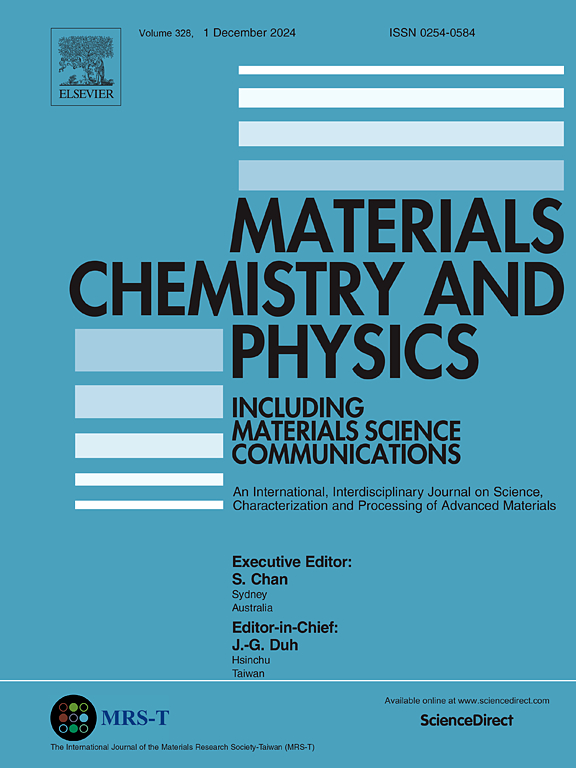Cs2AgBX6 (BBi, Sb)的光伏潜力探索X=Br, Cl)双钙钛矿的计算研究
IF 4.3
3区 材料科学
Q2 MATERIALS SCIENCE, MULTIDISCIPLINARY
引用次数: 0
摘要
双钙钛矿材料在解决卤化铅钙钛矿在实际应用中的毒性和不稳定性问题方面显示出巨大的潜力。特别是Cs2AgBX6 (BBi, Sb;X = Br, Cl)作为一种高效环保的铅基钙钛矿替代品引起了人们的广泛关注。本研究选择Cs2AgBX6作为太阳能电池的吸光层。结构计算表明,Cs2AgBX6是一种间接带隙半导体,带隙范围为0.9 ~ 1.8 eV,具有优异的光伏性能,特别是在可见光吸收范围内。具体来说,锑基钙钛矿的光学吸收系数为5 × 105 cm−1。此外,柯西压力对材料的弹性和脆性影响显著,实验结果表明,这四种材料都具有良好的弹性性能。材料的机械稳定性用杨氏模量、泊松比和其他力学参数来描述。仿真结果表明,Cs2AgBX6太阳能电池的功率转换效率(PCE)高达14.28%。因此,本研究不仅证明了Cs2AgBX6在光伏应用中的巨大潜力,也为其在器件应用中的进一步发展铺平了道路。本文章由计算机程序翻译,如有差异,请以英文原文为准。
Exploring the photovoltaic potential of Cs2AgBX6 (BBi, Sb; X=Br, Cl) double perovskites: A computational study
Double perovskite materials have shown significant potential in addressing the toxicity and instability issues of lead halide perovskites in practical applications. In particular, Cs2AgBX6 (B![]() Bi, Sb; X = Br, Cl) has attracted considerable attention as an efficient and environmentally friendly alternative to lead-based perovskites. In this study, Cs2AgBX6 is selected as the light-absorbing layer for solar cells. Structural calculations reveal that Cs2AgBX6 is an indirect bandgap semiconductor, with a bandgap ranging from 0.9 to 1.8 eV, exhibiting excellent photovoltaic performance, particularly within the visible light absorption range. Specifically, antimony-based perovskites demonstrate an outstanding optical absorption coefficient of 5 × 105 cm−1. Moreover, the Cauchy pressure significantly influences the material's elasticity and brittleness, with empirical results indicating that all four materials possess good elastic properties. The mechanical stability of the materials is described in terms of Young's modulus, Poisson's ratio, and other mechanical parameters. Simulation results for the solar cell show that Cs2AgBX6 achieves a power conversion efficiency (PCE) of up to 14.28 %. Therefore, this study not only demonstrates the immense potential of Cs2AgBX6 in photovoltaic applications but also paves the way for its further development in device applications.
Bi, Sb; X = Br, Cl) has attracted considerable attention as an efficient and environmentally friendly alternative to lead-based perovskites. In this study, Cs2AgBX6 is selected as the light-absorbing layer for solar cells. Structural calculations reveal that Cs2AgBX6 is an indirect bandgap semiconductor, with a bandgap ranging from 0.9 to 1.8 eV, exhibiting excellent photovoltaic performance, particularly within the visible light absorption range. Specifically, antimony-based perovskites demonstrate an outstanding optical absorption coefficient of 5 × 105 cm−1. Moreover, the Cauchy pressure significantly influences the material's elasticity and brittleness, with empirical results indicating that all four materials possess good elastic properties. The mechanical stability of the materials is described in terms of Young's modulus, Poisson's ratio, and other mechanical parameters. Simulation results for the solar cell show that Cs2AgBX6 achieves a power conversion efficiency (PCE) of up to 14.28 %. Therefore, this study not only demonstrates the immense potential of Cs2AgBX6 in photovoltaic applications but also paves the way for its further development in device applications.
求助全文
通过发布文献求助,成功后即可免费获取论文全文。
去求助
来源期刊

Materials Chemistry and Physics
工程技术-材料科学:综合
CiteScore
8.70
自引率
4.30%
发文量
1515
审稿时长
69 days
期刊介绍:
Materials Chemistry and Physics is devoted to short communications, full-length research papers and feature articles on interrelationships among structure, properties, processing and performance of materials. The Editors welcome manuscripts on thin films, surface and interface science, materials degradation and reliability, metallurgy, semiconductors and optoelectronic materials, fine ceramics, magnetics, superconductors, specialty polymers, nano-materials and composite materials.
 求助内容:
求助内容: 应助结果提醒方式:
应助结果提醒方式:


